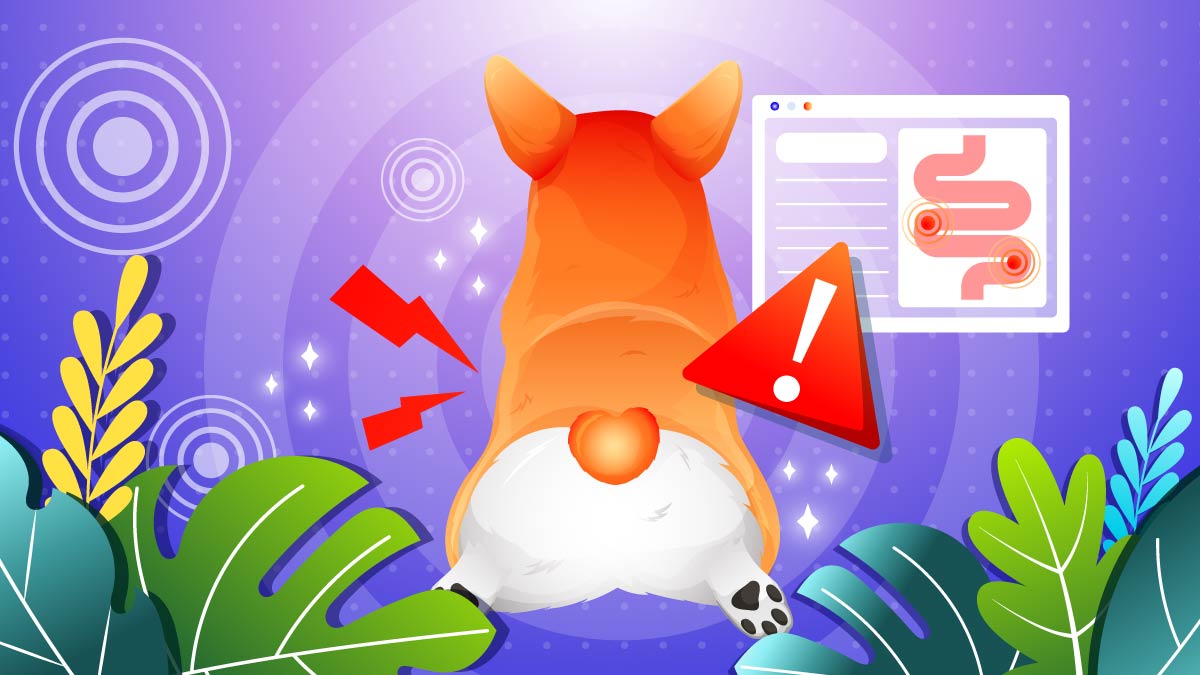What Can I Give My Dog for Constipation?

Constipation is quite common in dogs and refers to the inability to pass a regular stool on a daily basis.
Dogs can get constipated for a range of reasons. The treatment is usually easy, but some of our canine friends may experience chronic constipation. When untreated, the condition can turn into obstipation, which further dries and hardens the stool so the dog can’t defecate at all.
If you’re asking yourself, “What can I give my dog for constipation?” then you’ve come to the right place.
In this article, we cover 5 natural remedies for constipated dogs. We also explain when your dog may require veterinary intervention and how to tell that your dog is constipated in the first place.
What Can I Give My Dog for Constipation? (5 Natural Remedies)
 Before giving your dog anything for constipation, make sure to check to see what the problem is. If you have a long-haired dog or any dog who sheds a lot, it is your duty to carefully assist in removing the hair so the anus can perform its normal functions.
Before giving your dog anything for constipation, make sure to check to see what the problem is. If you have a long-haired dog or any dog who sheds a lot, it is your duty to carefully assist in removing the hair so the anus can perform its normal functions.
However, keep in mind not to use scissors when removing hair in this area. Clippers are a much safer option; you’d hate yourself for cutting or stabbing your dog’s anus because you were using scissors, and he swung suddenly — not to mention the embarrassment from explaining the situation to your vet.
Even if nothing is blocking the anal passage, observation may help you spot other reasons why your dog is constipated.
But let’s say you’ve already identified the cause and are looking for home remedies to help your buddy overcome the problem.
Here’s what you can give your dog for constipation.
Exercise Your Dog
One of the risk factors of constipation is lack of exercise. If your dog doesn’t play around regularly, then his digestive system will be affected by this lack of activity. Your dog needs to exercise to process and digest food, ensuring proper bowel movements. The less activity your dog gets, the more his body goes into cervical mode — starting to store food in the stomach and intestines instead of burning it for energy. This contributes to a harder fecal matter, which is much more difficult for your dog to pass than the regular stool.
Fortunately, vigorous exercise may help the fecal matter that has become impacted pass through the anus by breaking it up. Sometimes, your dog may struggle several times in an attempt to pass the impacted stool, but in the end, the poop will get loose.
Moreover, the smell of the outdoors makes your dog more willing to poop. His wild instincts will tell him to mark his territory with urine or a stool, and his nose will tell his tummy that it’s time to get rid of the ballast.
If exercising doesn’t bring the expected results, this may indicate that the fecal matter may be too large for your dog to pass. In this case, a visit to the vet may be required. Your veterinarian will most likely administer an enema to break up and remove the stool.
Provide Specific Stool Softeners
Sometimes your dog may need a little extra help, which makes stool softeners a handy solution for constipation. According to the American Kennel Club, stool softeners are useful for our canine friends because their digestive system is delicate and much different than the one of humans.
Stool softeners are laxative-based assistants that usually act fast (within 24 hours) and allow the dog to effectively pass the poop.
Stool softeners contain a high amount of fiber to help your dog during the struggle, but they aren’t the only things that can alleviate constipation in dogs. For example, canned pumpkin is touted by dog owners for its ability to promote healthy bowel movement, provide enough fiber, and hydrate the dog to push the fecal matter through their gut and right to its destination — out the other side.
You can give your dog both canned pumpkin and stool softeners, but only in small quantities. While these products are excellent when it comes to ‘invigorating’ your dog’s internal system, you should be careful not to overdo them. Once the dog has eaten dietary aids like pumpkin or stool softeners, take them out often so that he can finish his business — especially if your dog suffered from long-term constipation. Otherwise, you might end up having a messy accident.
Take Care of the Dog’s Hydration
One of the major factors contributing to canine constipation is dehydration. Your dog could be dehydrated even without showing any specific symptoms, but there are several signs that can indicate a problem with proper hydration, including:
- Dry mouth
- Dry nose
- Glazed over eyes
- Lethargy
- Loss of appetite
- Panting
- Thick foamy drool
- Vomiting.
According to veterinarians, the best practice to check your dog’s hydration is to gently pull on the excess skin behind his neck. If the skin snaps back quickly, then the dog is hydrated, but if not, this may indicate dehydration.
If dehydration is the cause of your dog’s constipation, water alone may not suffice. Consider adding bone broth and Pedialyte, which are both excellent aids for dehydration in dogs. When your dog becomes dehydrated, you may also need to administer electrolytes to bring the pH back to balance.
Whether you use a combination of water and broth or Pedialyte, make sure to add them in small increments to prevent further stomach issues. Your dog may be too dehydrated and lethargic to drink on his own, so you may need to help him drink it via a syringe. Simply put the syringe into the corners of his mouth and give him the hydrating solution.
It generally takes 24 hours for the dog’s bowel movements to normalize. As his body absorbs the electrolytes, you can begin to introduce regular water. If dehydration-triggered constipation becomes a frequent problem, you may want to consider dog-specific hydration supplements under the vet’s supervision.
Introduce Diet Modifications
If you notice a correlation between your dog’s eating habits and constipation, then the food could be the cause. While slight stomach issues are normal for dogs when making a transition to a new diet, things like constipation may be a sign that something is wrong with your friend’s nutrition; in other words, his diet may not be balanced for his dietary needs.
Nutrition is an essential part of your dog’s long-term health, and if the dog experiences regular constipation, you may need to switch to a vet-approved diet. Each veterinarian will give their own recommendations for dog food, but most pet dieticians will tell you that the dog should eat as little processed food as possible.
Once the healing process ends, the vet food may be replaced by a biologically appropriate diet. This means feeding the dog with food that he is naturally predisposed to consume, i.e. animals and their organs, maybe with some addition of berry fruits and dietary supplements recommended by a dietician. Many pet owners are turning to a BARF diet, which consists of biologically appropriate raw food and supplements like taurine or spirulina.
We recommend that you prepare your dog food from scratch. Although time-consuming and slightly more expensive than pre-made food, it’s a great way to ensure that the diet is tailored to his needs.
Use CBD for Constipation
CBD, or cannabidiol, is one of the most popular health supplements these days; it can be administered to both dogs and humans not only for constipation but also for a wide range of other health problems. Unlike conventional veterinary aids, CBD doesn’t cause life-threatening effects and can be safely used long-term.
CBD is one of the 115 active ingredients in cannabis plants known as cannabinoids. It’s non-intoxicating, so it won’t get your dog high, unlike THC. That’s because CBD doesn’t directly bind to the receptors of the endocannabinoid system (ECS).
The ECS is a vast neurochemical network responsible for maintaining homeostasis (balance) between all other systems and organs throughout the body. It controls functions like immune response, memory, mood, pain perception, gastrointestinal motility, body temperature, appetite, formation of new cells, and more. A properly working ECS ensures that we function in optimal health. On the other hand, a compromised ECS may lead to imbalances in the body, paving the way for the development of various disorders.
CBD interacts with the ECS and signals it to produce more of its natural messengers (endocannabinoids). In addition, it slows down their breakdown by inhibiting the enzyme that metabolizes them. Endocannabinoids are special ligands that bind to cannabinoid receptors in order to produce their health benefits and restore homeostasis in the body.
How Does CBD Help with Dog Constipation?
The connection between CBD and constipation relies on the interaction between cannabidiol and the cannabinoid receptors in the ECS. There are high concentrations of the CB2 receptors in a dog’s gut. When CBD circulates in the body, it can engage with CB2 receptors, providing an anti-inflammatory response and relaxing effects in the intestine muscles (1).
Long story short, CBD can both quiet the mind and relieve unnecessary physical tension. Just like it helps to relieve heavy stress in dogs, it also “tells” pain signals and inflammation markers to be at ease.
CBD also increases the levels of the body’s natural endocannabinoids, such as anandamide. Anandamide is responsible for controlling inflammation and pain response, and its deficiencies have been associated with a low pain threshold as well as mood instability and poor reactions to stress (2).
CBD can relieve constipation by promoting healthy gut motility and reducing pain and inflammation in the gut — all of which can contribute to dog constipation (3).
The best part about using CBD for constipation in dogs is a well-established safety profile. CBD is safe and well-tolerated by both humans and animals according to a 2017 report from the WHO.
CBD Oil or CBD Treats: Which is Better for Dog Constipation?
 Therapeutically speaking, CBD oil for dogs is better than CBD treats due to its higher bioavailability.
Therapeutically speaking, CBD oil for dogs is better than CBD treats due to its higher bioavailability.
Bioavailability refers to the amount of CBD that ends up in your circulatory system. In other words, not all of the ingested CBD reaches your system. Some consumption methods like vaping provide high bioavailability (56%), while others score a bit lower (e.g. sublingual consumption, 35%).
Oral forms of CBD such as pet treats have the lowest bioavailability of all consumption methods. In the best-case scenario, your dog will absorb 20% of the ingested CBD content because the CBD needs to pass through the digestive system first. From there, it is released by the liver into the bloodstream, so the effects are not only less potent but also delayed.
The effects of CBD dog treats are usually noticeable after 40 minutes from consumption, although some dogs experience them after 1–2 hours. The good thing about this delay is that the CBD is released gradually, so the effects are stretched over time. In other words, oral forms of CBD provide longer-lasting relief than other forms.
CBD dog treats are also preferred by fussy dogs who turn their noses away from natural CBD oil. Unflavored CBD oils have a distinct, earthy flavor. Depending on the strain used for extraction, it can taste grassy or leave a dill-like aftertaste on the tongue. The stronger the oil, the harsher it will get on the user’s throat. Pet treats, on the other hand, come in a range of delicious flavors for dogs, such as Peanut Butter and Apple, Cheese, or Bacon. They help mask the hempy flavor, and if the treats are made with CBD isolate, the earthy aftertaste is unnoticeable.
Just keep in mind that you’ll need to give your dog more CBD treats to achieve the same effect as with CBD oil, so the treats will work better as an addition to his diet rather than the cornerstone of his CBD supplementation due to the additional ingredients and calories they come with.
Best CBD Oils for Dogs with Constipation (Editor’s Picks)
1. Royal CBD (Best CBD Oil for Dog Overall)
Get 15% off all Royal CBD products. Use code “CFAH” at checkout.
Pros:
- Organic hemp from Colorado
- Full-spectrum CBD
- Up to 500 mg of CBD per bottle
- Good for dogs of different sizes
- Bacon flavor
Cons:
- Only one flavor option
- Not available in local stores
Royal CBD is one of the most reputable names in the CBD space. Launched in 2017 in California by a group of biotechnologists, researchers, and activists, it has quickly become a leading brand that offers a wide selection of CBD extracts, including a line of CBD products for dogs.
Royal CBD uses organic hemp, infuses its products with full-spectrum CBD, and tests them for their phytochemical profiles and purity in an independent laboratory.
You can choose from two types of products: CBD pet oil and three versions of dog treats formulated with different health needs in mind.
The Royal CBD pet oil comes in three potency variants: 125 mg (small dogs), 250 mg (medium dogs), and 500 mg (large dogs). Each of these strengths is available in the bacon flavor, making CBD oil more enjoyable for your pup.
As mentioned, this is a full-spectrum extract, which makes it superior compared to isolates in terms of its efficacy in improving your dog’s well-being.
2. Gold Bee (Runner Up)
Pros:
- Organic hemp from California
- Full-spectrum CBD
- 600 mg of total CBD
- Peanut butter flavor
- Third-party tested for quality and safety
Cons:
- No low-strength oils for extra small dogs
- Only one flavor option
Gold Bee started out as a superfoods company, making organic raw honey and coconut oil before enrolling in the CBD space. Today, it is one of the most recognizable companies on the market thanks to its unique formulations, organic ingredients, and integrity between farming and testing.
The Gold Bee CBD oil offers only one potency — 600 mg — which is best suited for medium-sized and large dogs. It can also be very cost-effective for smaller breeds, but dosing can turn out difficult due to the limited scale on the dropper. The oil comes in a peanut butter flavor, so it’s a good alternative to unflavored CBD oils for dogs who dislike their hempy aftertaste.
Gold Bee also offers delicious Goofy Bones (CBD dog treats) that involve a formula for stress relief and immunity boost.
All of Gold Bee’s products are tested for potency and purity in an independent laboratory.
What is Constipation?
From the medical point of view, constipation is the inability to pass a normal stool regularly. Interestingly, constipation doesn’t always mean there’s a hard stool that refuses to leave the body. The sensation is also described as an inability to go despite the need or feeling.
As a pet parent, it may be difficult to identify any dog constipation symptoms. You can, however, notice that your canine shows certain signs of discomfort while trying to answer the call of nature.
3 Major Types of Constipation in Dogs
- Extraluminal Constipation – characterized by the blockage of the colon due to an outside source
- Intraluminal Constipation – refers to a blockage in the colon that prevents the stool from passing
- Intrinsic Constipation – occurs as a result of hormone imbalances or neurological conditions in the body
Now let’s take a look at how to tell that your dog struggles with constipation.
Signs of Dog Constipation
 In order to treat dog constipation, it must be properly diagnosed. Watch out for any canine constipation symptoms if you suspect your four-legged buddy is having a digestive problem. If your dog regularly passes stools that are similar in size and consistency, it will be easy to identify constipation because the size and consistency, as well as the frequency of passing, will be “abnormal.”
In order to treat dog constipation, it must be properly diagnosed. Watch out for any canine constipation symptoms if you suspect your four-legged buddy is having a digestive problem. If your dog regularly passes stools that are similar in size and consistency, it will be easy to identify constipation because the size and consistency, as well as the frequency of passing, will be “abnormal.”
Common signs of dog constipation include:
- Dry, hard, and small stools
- Foreign bodies in the stool (e.g. grass, hairball)
- Loss of appetite
- Nausea
- Vomiting
- Difficulty urinating
- Licking the rectal area
- Gnawing or biting at the tail
- Scooting (dragging his hindquarters along the floor in an effort to alleviate the pressure from his anus)
Speaking of scooting, this motion may be a sign that your dog requires veterinary intervention. You can try to help the dog alleviate some pressure by gently rubbing his intestines in the area where his lower abdomen meets the hip joints. If you hear your dog snarling, growling, wincing, or whining while you’re touching his lower abdomen, stop right away and call your vet for an appointment.
Common Causes of Constipation
Your dog can get constipated for several potential reasons. The most common is intraluminal constipation caused by foreign objects like swallowed items or tumors blocking the colon from the inside.
More often than not, the cause of constipation may be as simple as something like grass, string, or hair that can eventually be passed. In rare scenarios, the obstruction must be dealt with via surgery or an enema bag.
Other common causes of constipation in dogs are as follows:
- Anxiety and stress
- Arthritis
- Change in diet
- Dehydration
- Damage to the anal cavity
- Intestinal obstructions
- Lack of exercise
- Matted fur
- Neurological disease
As we said, the problem can be easily treated at home in most cases. In the next section, we provide a list of 5 natural remedies that you can give your dog for constipation.
When to Take a Constipated Dog to the Vet?
The moment you become aware of your dog’s constipation, it’s a good idea to call a vet on top of giving the dog natural remedies to relieve it. Constipation can be a sign of some very serious diseases.
Chronic constipation may result in a buildup of dried fecal matter, which we previously mentioned as obstipation. This may cause another condition characterized by an inability to pass the stool – megacolon. The colon becomes clogged and loses its ability to move the fecal matter along. Chronic constipation is both a risk factor and symptom of this disorder.
Your vet may ask you the following questions, so make sure that you come well-prepared:
- What’s the color and consistency of the stool?
- Have you recently introduced any changes to the dog’s diet?
- When was the last time your dog had a normal bowel movement?
- Did your dog eat any non-food items?
- Does the dog strain while trying to go?
- Have you given him any home remedies for constipation?
- Has your dog recently had an injury?
- Did you notice other signs of discomfort, such as vomiting, lethargy, or bloating?
The vet may also run several tests, including:
- Abdominal palpation
- Barium enema
- Complete blood count
- Neurological exam
- Radiographs of the abdominal area
- Ultrasound or colonoscopy
- Urinalysis
Veterinary Treatment & Prevention
Most cases of dog constipation can be managed with mild treatments, such as hydrating the dog and ensuring the necessary amount of dietary fiber or getting more exercise. Laxative suppositories and enemas may come in handy, but should only be used as recommended by a veterinarian — especially if they are required for long periods.
More severe cases of constipation may call for medical intervention, such as:
- Manual removal of the stool
- Medications that activate normal colon function or inhibit the activity of certain enzymes
- Surgery (very rare, extreme cases)
For the majority of dogs, constipation will be a rare problem. You can keep it under control through a well-balanced diet, regular exercise, and by providing a sufficient amount of fresh water daily.
Final Thoughts on Dog Constipation & How to Treat It
Constipation is a real problem and should never be ignored. When identified early enough, it can be managed through a few home remedies, including herbal extracts like CBD oil. CBD oil can be particularly useful not only for dogs with diarrhea but even for those with constipation because it promotes healthy bowel movement through the mammalian endocannabinoid system, which plays a very important role in the functioning of the digestive tract.
If your dog’s bowel movement is disrupted and makes them unable to pass a stool between 48 and 72 hours, it’s an indicator that you need to take him to the veterinarian. Home remedies like the ones provided above are great as a means of first-step intervention, but there’s a point where medical attention is required.
Reference links:
- Hasenoehrl, C et al. “The gastrointestinal tract – a central organ of cannabinoid signaling in health and disease.” Neurogastroenterology and motility : the official journal of the European Gastrointestinal Motility Society vol. 28,12 (2016): 1765-1780. doi:10.1111/nmo.12931
- Leweke, F M et al. “Cannabidiol enhances anandamide signaling and alleviates psychotic symptoms of schizophrenia.” Translational psychiatry vol. 2,3 e94. 20 Mar. 2012, doi:10.1038/tp.2012.15
- Camilleri, M. “Cannabinoids and gastrointestinal motility: Pharmacology, clinical effects, and potential therapeutics in humans.” Neurogastroenterology and motility : the official journal of the European Gastrointestinal Motility Society vol. 30,9 (2018): e13370. doi:10.1111/nmo.13370

